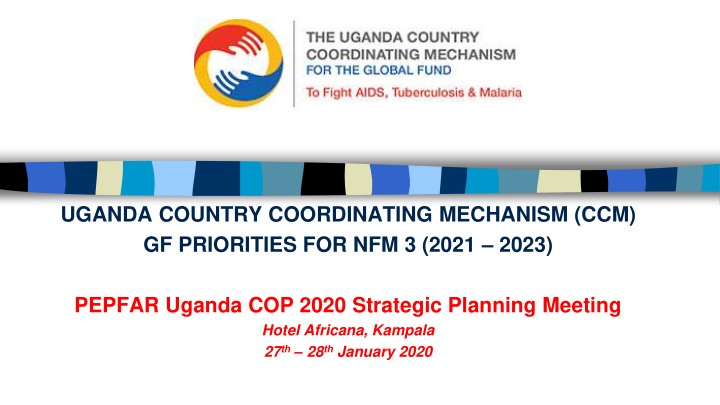



UGANDA COUNTRY COORDINATING MECHANISM (CCM) GF PRIORITIES FOR NFM 3 (2021 – 2023) PEPFAR Uganda COP 2020 Strategic Planning Meeting Hotel Africana, Kampala 27 th – 28 th January 2020
Mandate & Role of the CCM ◼ The core mandate of the UCCM is to mobilise resources from the Global Fund and subsequently oversee this investment for HIV, TB, Malaria and Resilient and Sustainable Health Systems to ensure the supported programmes achieve their targets, contribute to the reduction of the three epidemics and facilitate Uganda to achieve universal healthcare goals. ◼ The CCM focuses on strategic oversight that addresses bottlenecks in grant management and implementation, ensures that the grant strategy is translated into effective implementation approaches and the grants are effectively harmonised with other in-country initiatives. SENSITIVE BUT UNCLASSIFIED
GF Grant Allocations for NFM 3 Eligible disease component Allocation (US$) Allocation Utilization Period HIV 289,203,023 1 January 2021 to 31 December 2023 Tuberculosis 29,773,958 1 January 2021 to 31 December 2023 Malaria 260,024,950 1 January 2021 to 31 December 2023 Total 579,001,931 Uganda is eligible for additional catalytic matching funds beyond the allocation amount above. Priority Area Allocation (US$) Adolescent Girls and Young Women in High 4,700,000 Prevalence Settings US$ Condom Programming 2,500,000 Differentiated HIV Service Delivery (Self-Testing) 2,900,000 602.5 M Finding Missing People with TB 6,000,000 Human Rights 4,400,000 Improved Data Science in Community Health 3,000,000 Total 23,500,000 SENSITIVE BUT UNCLASSIFIED
NFM 3 Priorities - HIV • Prevention • Care and treatment- For 95:95:95 by 2020 and beyond • HTS-commodities(Test Kits- RDTs • ART-commodities(ARVs, VL, CD4, and Self testing) • BCC/IEC - Prevention messaging CTX) • Differentiation of treatment and • Condom Programming care • Application of new biomedical • TB/HIV collaboration technologies - Prep, • PMTCT - (retention, EID) • Program management • AGYWs and especially keeping • Human Resources and Girls in School coordination • Key and Priority Population • Monitoring and Evaluation Programming • RSSH and Community SSH • Reduce human rights-related barriers to HIV services SENSITIVE BUT UNCLASSIFIED
NFM 3 Priorities - TB • Care and Prevention • Reducing human rights and gender related • Prevention - Target >90% of eligible persons barriers to TB services (Increase TPT Coverage; Strengthen tracing & • Stigma and discrimination reduction & evaluation of U5 and other Contacts) community mobilization. Target all the • Key populations (prisoners, health workers, 90,90,90 school and household contacts of TB cases • Resilient Sustainable Systems for Health - RSSH • Raise awareness about TB • Increase coverage of TB diagnosis-(Detection • Community system strengthening (Target 90,90,90 of TB Cases)- Target >90% • Engaging all care providers • Commodities & supplies for TB • TB Treatment • RSSH and Community SSH • Treatment completion. TSR>90% • Strengthen HIS and M&E Systems • TB/HIV • Operational research/surveys • TB/HIV collaboration (TB/HIV Prevention and • Program Management Diagnosis) • Human • MDR TB Resources - Coordination and management of national disease response • Case detection and diagnosis • Financing • Treatment SENSITIVE BUT UNCLASSIFIED
NFM 3 Priorities - MALARIA ➢ Sustain and scale up VC interventions LLINs, IRS, and LSM through innovative approaches ➢ Commodity security (ACTs, RDTs, LLIN) ➢ Strengthening Primary Health Care through targeted and institutionalized community-based services delivery (Targeting high risk and hard-to-reach populations) ➢ Improve quality of care (Severe malaria, MiP) ➢ Support the operationalization of MAAM at all levels national, Regional and sub national levels ➢ Sustain and strengthen human resource capacity at all levels to deliver malaria control /elimination interventions ( Guidelines, Supervision etc) ➢ Data-Informed Decision-Making for impact along the continuum to malaria elimination (Health facility, private sector and Community, E-health platforms) ➢ Strengthen Epidemic preparedness (IDSR, integrated response, multisector) ➢ RSSH-Infrastructure development (Building NDPC Centre; MAL/TB/ HIV Home) SENSITIVE BUT UNCLASSIFIED
NFM 3 Priorities - RSSH ➢ Community systems strengthening in a people oriented, resilient health system/Data science catalytic funding ➢ Health information using appropriate state of the art information technology ➢ Service delivery including commodity management considering that about 80% of the program area allocation is always earmarked for commodities ➢ Governance and ownership ➢ Human resource capacity building ➢ Infrastructure building ➢ Health promotion with effective communication system SENSITIVE BUT UNCLASSIFIED
Key Unfunded Priorities ◼ Strengthening CCM Strategic Oversight of the Global Fund Investments ◼ Commodities and Supplies; – ARVS - 375,971,162 USD – Cotrimoxale - 10,408,788 USD – Male Condoms - 74,426,319 USD – HIV/AIDS Lab Requirements - 235,935,541 USD – TB medicines - 31,860,276.57 USD – TB Lab supplies - 47,491,972.60 USD ◼ Medical Waste management in public health facilities ◼ Traceability and accountability of medicines at all levels ◼ Integrated community services through engagement of community based organizations and networks ◼ IRS for regions with high malaria burden ◼ Storage capacity at lower level health facilities for health commodities SENSITIVE BUT UNCLASSIFIED
SENSITIVE BUT UNCLASSIFIED
Recommend
More recommend